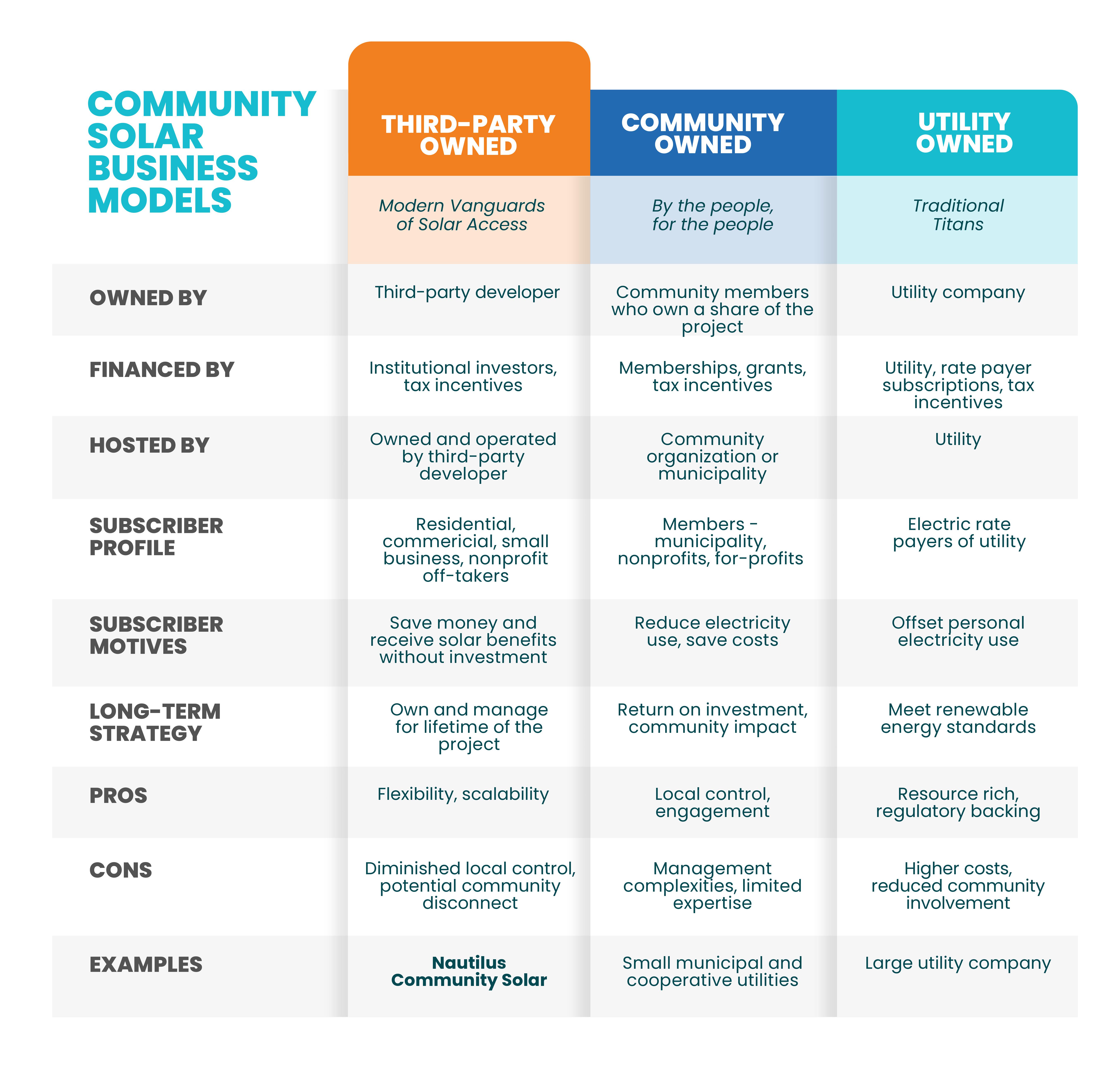February 27, 2024
A Deep Dive into Community Solar Business Models: Pros/Cons
Key Messages
- Community solar models, including third-party, community, and utility-led frameworks, are pivotal in democratizing access to clean energy, especially for low-to-moderate-income groups.
- While each model has its strengths and weaknesses, the third-party-led system stands out for its adaptability and potential for rapid scaling, holding a distinct edge in promoting broader access to solar energy.
- Active engagement in community and utility-led solar projects remains essential; however, leveraging the flexibility of the third-party-led model can be a strategic move in the swift expansion of community solar initiatives.
Sustainable community solar development has emerged as a rising star in the renewable energy industry, offering individuals and businesses the opportunity to tap into the power of the sun without the necessity of installing solar panels on their property. Community solar allows individuals and businesses to subscribe to or own a portion of a distributed solar system located in their local utility service territory and receive savings based on their share of solar produced. While community solar programs offer many benefits to businesses, including access to renewable energy, cost savings, and reduced carbon footprint, not all community solar business models are created equal. A successful expansion of the program and the equitable accessibility of it depends on the right business model and the unique value proposition for various stakeholders.
Currently, three prominent business models dominate the community solar marketplace — third-party-led/owned, community-led/owned, and utility-led/owned. Each of these models has its unique advantages and disadvantages:
Third-Party-Led/Owned Model: The Modern Vanguards of Solar Access
Pros:
- Flexibility: Eclipses its counterparts in terms of adaptability to market demands.
- Scalability: Offers the most expansive scale, thanks to the substantial financial backing third-party developers possess.
- Expertise: Engages seasoned professionals adept in spearheading and managing projects efficiently over the long term.
- Diverse Revenue: Dual streams from power sales to customers and tax credits provide a robust financial foundation.
Cons:
- Profit-driven: Motivation to maximize profits could potentially override other pivotal aspects, including equitable access.
- Diminished Local Control: Customers have less control over and involvement in the project.
- Community Disconnect: External ownership could mean lesser grassroots understanding and alignment.
Spotlight Example:
Imagine a residential area located close to a third-party-owned community solar project. By simply subscribing, residents can benefit from the local energy produced and enjoy lower electricity costs without being bound by long-term agreements. However, their input on the project’s operations is limited. The external owner, with substantial financial backing, handles the sustainable community solar development and management of the project, achieving both scale and efficiency.
Community-Led/Owned Model: By the People, For the People
Pros:
- Local Control: Greater degree of control and influence through community-driven ownership.
- Unified Engagement: Enhanced cohesion and support, given the community's stake in success.
- Inclusivity: Tailored to prioritize the participation of low and moderate-income households, promoting fairness in energy access.
Cons:
- Scaling Hurdles: Expansion difficulties due to limited access to capital and resources.
- Management Complexities: Demands substantial coordination and consensus-building among community members.
- Limited Expertise: May suffer from a lack of necessary expertise for streamlined operation.
Spotlight Example:
A close-knit community comes together to own and govern a solar project, immersing themselves in every facet of decision-making and enjoying the ensuing benefits. Yet, this model calls for significant time, effort, and financial resources, including securing initial funding for construction.
Utility-Led/Owned Model: The Traditional Titans
Pros:
- Resource Rich: Utilities bring substantial capital and resources to the table, facilitating the creation of large-scale projects.
- Regulatory Backing: Receives regulatory support and incentives, enhancing financial viability.
- Reliability: Offers a stable and dependable choice for customers, given the backing of an established utility company.
Cons:
- Reduced Community Involvement: May not fully align with local needs due to limited community engagement.
- Higher Costs: Regulatory compliance and profit margins can drive up project costs.
- Equity Concerns: May not prioritize or recognize the diverse needs of low and moderate-income subscribers.
Spotlight Example:
A utility company launches a community solar project in its territory, providing customers access to clean energy. While reliable, it might not fully embrace community-led efforts, potentially overlooking local preferences. The model's trustworthiness might be counterbalanced by its potential oversight of community-driven priorities.

The quest to democratize access to clean energy through community solar, particularly for the underserved low-to-moderate-income groups, every business model has its advantages. Community-led and utility-led approaches undeniably have their merits, but the third-party-led system, especially when viewed through the lens of Nautilus Solar's execution, truly sets itself apart. This model boasts unparalleled adaptability and a high ceiling for rapid expansion. At Nautilus Solar, we enhance these inherent advantages with our formidable financial strength, deep expertise as a pioneer in the solar sector, and nimble flexibility. Nautilus’s unwavering commitment to growth and fostering strategic partnerships further amplifies their ability to champion the third-party model. As we look towards the future of the community solar industry, it's clear that the third-party model emerges as a leader, providing a broader and more inclusive option for sustainable community development.
